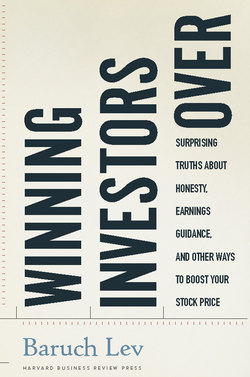Читать книгу Winning Investors Over - Baruch Lev - Страница 27
На сайте Литреса книга снята с продажи.
Truth in Accounting?
ОглавлениеLying in financial reporting as elsewhere is universally condemned. An absolutist rejection of lying, on moralistic grounds, has a long-standing tradition. The ninth of the ten commandments delivered by Moses from Mount Sinai states emphatically: “You shall not bear false witness against your fellow.” St. Augustine adds: “Now it is evident that speech was given to man, not that men might therewith deceive one another, but that one man might make his thoughts known to another. To use speech, then, for the purpose of deception, and not for its appointed end, is a sin.” Fast-forward fourteen centuries to hear Immanuel Kant declare that a lie is “a crime of man against his own person and a baseness which must make a man contemptible in his own eyes.” When asked if a lie is permitted to save a life, Kant answered: “To be truthful (honest) in all declarations, therefore, is a sacred and absolutely commanding decree of reason, limited by no expediency.”3
Realists, keen observers of life and human nature, have taken a more pragmatic and nuanced approach to deception. Plato “had allowed that in his ideal Republic, rulers, the very topmost executives of the state, might find it ‘necessary’ to lie for the good of the community, and Machiavelli most wholeheartedly agreed with him.”4 Iris Murdoch sarcastically noted: “We have to mix a little falsehood into truth to make it plausible.”5 In a competitive environment, marked by the struggle to survive, lies and deceptions are often a part of life. Jeremy Campbell notes the following:
In the world of life, even fairly primitive life, Darwin recognized that falsehood and chicanery are part of the game of survival. Writing in the Descent of Man, he commanded as “admirable” a paper by the entomologist Henry Walter Bates on mimicry in nature…. Mimicry in effect was a pretense, a form of lying, a means of gaining an edge on survival by deceiving predators as to the “real” character of their potential victims6 … Adaptation to the conditions of life … can and does involve deception. That is a major theme of evolutionary studies today. Certain species flourishing now might be extinct if they had depended on truthfulness to increase and multiply.7
It may seem a short step from deception by species for survival to the fiercely competitive business world, where the struggle to prevail and prosper is as fierce as in nature. This, however, is a step fraught with danger. Truthfulness is the bedrock of all social and economic arrangements. No economic institution, be it a corporation or a stock market, can survive if falsehood in loan or labor contracts, manipulation in financial statements, or fraud in auditors’ reports are tolerated. Who will work, lend money, or invest in securities when lies are permitted in contractual agreements? Obviously, for economic and social institutions to survive, truth must govern all arrangements, a theme I emphasize throughout this book. But, and this is the crux of the issue, what is truth and its converse—a lie?
Simple. Truth is universally believed to be correspondence with facts. Lying, with misstating facts. Thus, for example, in the early 2000s when Parmalat, a large Italian dairy company, presented on its balance sheets multibillion-dollar deposits in the Bank of America, where there were none, it lied. Things become murkier with accounting estimates, prevalent in financial reports. Consider a 12 percent annual depreciation expense on a firm’s machinery. True, or deceptive expense intended to inflate earnings? That’s hard to say, since depreciation is an estimate derived from a prediction of the future useful life and productivity of the machinery. There are no facts to substantiate the 12 percent rate and, therefore, no unequivocal answer to the true-or-false question.8 The situation is similar to a bank’s loan loss reserve, a major expense item, which is based on estimated future losses from delinquent borrowers. There are no corresponding facts here either at the time the estimate is made—just managers’ judgment of the creditworthiness of borrowers. Even if it were to turn out later on that managers had seriously underestimated the loan loss reserve, it would be next to impossible to prove that at the time they made the estimate it was fraudulent. And what about the impairment or loss of value charges of long-term assets or goodwill, which are based on estimated future cash flows from these assets? There are no facts here either. And how about the ultimate noncorrespondence with facts—the marked-to-market toxic assets of banks during the financial crisis from 2007 to 2008, when no market for these assets in fact existed? Mark-to-myth would be a better description, quipped Warren Buffett. The list of estimates, forecasts, and subjective judgments underlying financial information covers most balance sheet and income statement items. Thus, unbeknownst to nonaccountants, in corporate financial reports, there are very few facts to establish truth or duplicity.9 What then substitutes for correspondence with facts as a truth criterion in financial information?
